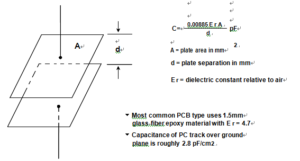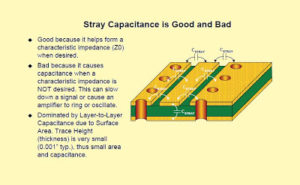Electronic PCB Board Stray Capacitance
When two conductors aren’t short-circuited together in the Electronic PCB Board Stray Capacitance, or totally screened from each other by a conducting (Faraday) screen, there is a capacitance between them. So, on any Electronic PCB Board, there will be a large number of capacitors associated with any circuit (which may or may not be considered in models of the circuit). Where high frequency performance matters (and even dc and VLF circuits may use devices with high Ft and therefore be vulnerable to HF instability), it is very important to consider the effects of this stray capacitance.
Any basic textbook will provide formulas for the capacitance of parallel wires and other geometric configurations. The example we need consider in this discussion is the parallel plate capacitor, often formed by conductors on opposite sides of a Electronic PCB Board. The basic diagram describing this capacitance is shown in below Figure:
Neglecting edge effects, the capacitance of two parallel plates of area A mm2 and separation d mm in a medium of dielectric constant Er relative to air is:
0.00885 Er A/d pF.
where:
Er = the dielectric constant of the insulator material relative to air
A = the plate area
D = the distance between the plates
From this formula, we can calculate that for general purpose Electronic PCB Board material (Er = 4.7, d = 1.5 mm), the capacitance between conductors on opposite sides of the board is just under 3 pF/cm2.
In general, such capacitance will be parasitic, and circuits must be designed so that it does not affect their performance. While it is possible to use Electronic PCB Board capacitance in place of small discrete capacitors, the dielectric properties of common Electronic PCB Board substrate materials cause such capacitors to behave poorly.
They have a rather high temperature coefficient and poor Q at high frequencies, which makes them unsuitable for many applications. Electronic PCB Boards made with lower loss dielectrics such as Teflon are expensive exceptions to this rule.



